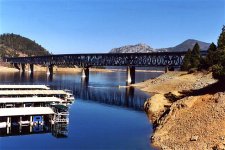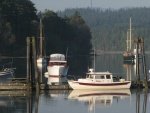There's another bridge on I-5 that would be a major disaster if it were lost, the Pit River Bridge over Shasta Lake, just 15 minutes north of Redding.
It handles not only all the load of trucks and cars on I-5, but also all of the train traffic gong north/south in on the
West Coast that doesn't go around the backside of the Sierras and the Cascades.

(My CD-22 and Sea Ray SB-265 are in the covered marina in the photo above.)
Here's an article on what it's loss to terrorism or a natural disaster (earthquake) would mean:
(from the Redding Record-Searchlight, 2007)
Caltrans Braced for Disaster: Department Has Contingency Plan for Pit River Span
Ed Lamkin of the California Department of Transportation gets paid to think the unthinkable -- what would happen if terrorists or some other disaster disabled or destroyed the Pit River bridge over Lake Shasta, a road and rail link vital to West Coast transportation and commerce?
At a minimum, he said, it could mean months if not years of diverting traffic on a time-consuming 125-mile detour through Burney or on roads to the coast.
"It's a big concern of ours," Lamkin said this week. "We have been leery of it (a terror attack) since 9/11. It certainly woke us up."
Lamkin, a 50-year-old engineer who grew up in northern Michigan, is deputy district director for maintenance and traffic operations in Caltrans' Redding office. He carries a contingency plan wherever he goes. It includes traffic diversion and detour scenarios, and pages of contact numbers.
The Pit River bridge, a 3,600-foot-long span completed in 1941, sees an average of 37,800 vehicles a day, about a quarter of them trucks. Union Pacific trains pass on tracks under the roadway. The bridge is undergoing work to replace its aging deck, a $21.5 million, two-year project scheduled to be finished in June 2008. (Caltrans originally reserved $50 million for the work, Lamkin said.)
The bridge is "extremely vital" to transportation and commerce on the West Coast, Lamkin said. If it were put out of commission, the cost to users would be $4 million to $5 million a day, he said.
A Timothy McVeigh-style truck bomb "would likely result in a hole in the deck" rather than the loss of a span, Lamkin said. "It's a very strong structure," he said of the concrete and steel-truss bridge. The bridge was built to support two trains at once, he noted. There's only one active track on the bridge. Given the "extremely large concrete piers" that support the bridge, Lamkin said, "I don't see it being vulnerable from the lake (side)." When the lake is full, there's only about 25 feet of clearance between the bridge and the lake surface, he said.
A camera on the bridge is monitored in Caltrans' traffic management center on Riverside Drive in Redding. The agency "works very closely" with the California Highway Patrol to protect the bridge, Lamkin said, declining to offer specifics.
The CHP has beefed up patrols in the area and has officers on the bridge 24 hours a day during holidays and at peak travel times, said Joe Micheletti, a lieutenant at the CHP's Redding area office. "But it's almost physically impossible to 100 percent protect these infrastructure items," Micheletti said. "You have limited resources and do the best you can. We rely on the eyes of the public, too."
Earlier this year, thieves stole tools from a Union Pacific storage shed at the north end of the bridge. The engineer of a passing train noticed the theft in progress and notified law enforcement. The suspects were arrested moments later near the Turntable Bay interchange, said Tony Pascal, a Caltrans engineer.
After the Sept. 11 attacks, construction plans for the bridge are "considered sensitive information," Lamkin said. "We're not going to give copies of the as-built' plans to any contractor who hasn't undergone a security background check." Martinez-based Gold State Bridges is the general contractor on the deck job.
If serious damage occurred to the structure, Caltrans would award an emergency contract to fix it, Lamkin said, similar to the contract awarded to C.C. Meyers Inc. to repair the Santa Monica Freeway after the 1994 Northridge Earthquake. The contractor received an incentive to complete the work quickly, a contract provision that resulted in an additional $14 million payment, he said.
The bridge was built and is owned by the Bureau of Land Management. Caltrans and Union Pacific are responsible for maintaining the structure.
To replace the bridge today would cost $500 million -- "a real ballpark estimate," Lamkin said. It was widened in 1966 to four lanes with two-foot shoulders.
Caltrans "would like to replace the bridge in the next 20 years," he said.
"That bridge is extremely strong," Lamkin said. "With proper maintenance and painting, it could last another 100 years."
NOTE: Cal Trans is currently replacing the second bridge over Lake Shasta at Lakehead, ~15 miles north of the Pit River Bridge. It does not carry train traffic, but is also a single/vital link of I-5. -Joe.)
Joe. :teeth :thup


